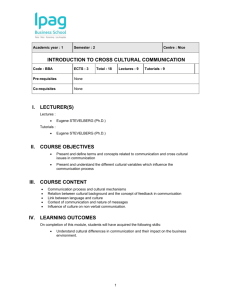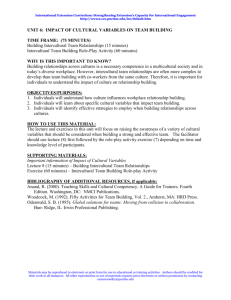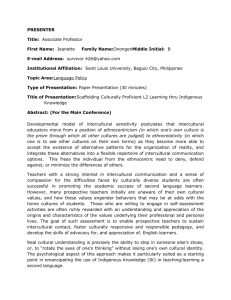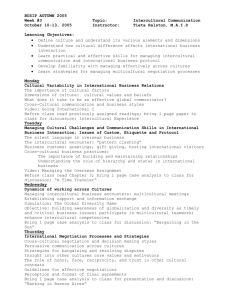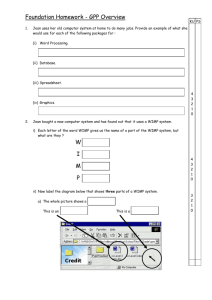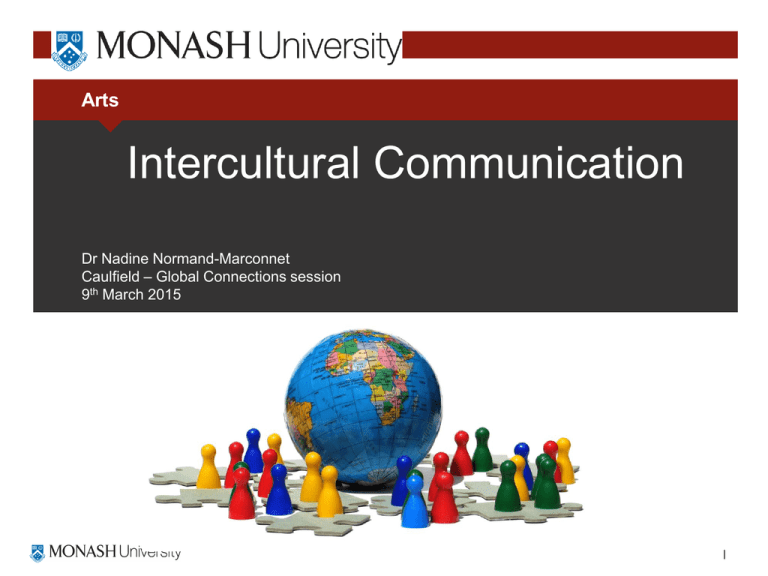
Arts
Intercultural Communication
Dr Nadine Normand-Marconnet
Caulfield – Global Connections session
9th March 2015
Definition of culture
Beliefs
Values
Basic understanding of
a group of people about
what the world is like or
what is true or false
What a group of people
defines as good and ad
or what it regards as
important
Norms
Rules for appropriate
behavior, which provide
the expectations people
have of one antoher
and of themselves
Social Practices
The predictable
behavior patterns that
members of a culture
typically follow
Lustig, M., Koester, J. (2013, 7th ed.) Intercultural Competence. Upper Saddle River,
N.J. : Pearson Prentice Hall Pearson. (p.26)
Dr Nadine Normand-Marconnet, Global Connections, 9/3/2015
2
Definition of ‘intercultural challenge’
The ‘intercultural challenge iceberg’, from Pamela Kittler, Food and Culture ( 2001, 3rd ed.)
Race
Gender
Age
Nationality
Acculturation/assimilation
Socioeconomics status
Occupation
Health condition
Religion
Sexual preference
Group membership
Educational background
Political orientation
Dr Nadine Normand-Marconnet, Global Connections, 9/3/2015
3
Definition of Intercultural Communication
Intercultural communication is a
symbolic, interpretative,
transactional, contextual process
in which people from different
cultures create shared meanings.
(Lustig & Koester, 2013:43)
Intercultural communication occurs when
large and important cultural differences
create dissimilar interpretations and
expectations about how to communicate
competently. (Lustig & Koester, 2013 :48)
A situation where people from different cultural
backgrounds come into contact with each other; or a
subject of study that is concerned with interactions
among people of different cultural and ethnic groups
and comparative studies of communication
patterns across cultures (Zhu Hua, 2011: 422)
Dr Nadine Normand-Marconnet, Global Connections, 9/3/2015
4
Cross-cultural or intercultural communication?
Cross-cultural communication
Intercultural communication
Compares and contrasts native
discourse and communication
styles /behaviours in different
cultures
Involves an investigation of
interpersonal interaction
between individual (or groups)
from diverse linguistic and
cultural background.
E.g. : behaviour of business
students in case discussion in
Saudia Arabia behaviour of
business students in case
discussion in Malaysia
E.g. : a South Korean student in
Seoul interacting in English with
an exchange student from
Sweden
(Jackson, 2014: 3)
Dr Nadine Normand-Marconnet, Global Connections, 9/3/2015
5
Reasons to study IC
The study of Intercultural communication is bout acquiring the necessary
knowledge and dynamic skills to manage differences appropriately and
effectively. It is also about developing a creative mind-set to see things from
different angles without rigid pre-judgement. (Ting-Toomey & Chung, 2005: 3)
Imperative for learning more about IC?
Globalisation
Internationalisation
Communication/transportation technologies
Demographic changes
Conflict and Peace
Ethics
Personal skills (self-awareness, creative problem solving, etc.)
Dr Nadine Normand-Marconnet, Global Connections, 9/3/2015
6
E.T. Hall (1976): Three dimensions of cultural difference
- Monochronic-polychronic time
- Low-high context of communication
- Use of personal space
Unambiguous and straightforward
messages
Meaning comes from context, not
from words
Direct communication
Indirect communication
Monochronistic
Polychronistic
LOW CONTEXT CULTURES
HIGH CONTEXT CULTURES
Individualistic oriented cultures
Collectivist oriented cultures
Dr Nadine Normand-Marconnet, Global Connections, 9/3/2015
7
Activity 3: where do you place UK, Malaysia and Australia in this
triangle illustrating cultural types? Follow the colour code.
Red = multi-active – warm, emotional,
loquacious, impulsive
Blue = linear-active – cool, factual,
decisive planners
Multiactive
Brazil, Chile, Mexico
Yellow = reactive – courteous, amiable,
accommodating, compromiser, good
listener
India
Belgium, Israel
Germany,
Switzerland
Linearactive
Reactive
Vietnam
Canada
The Lewis Model: http://www.crossculture.com/services/cross-culture/
Dr Nadine Normand-Marconnet, Global Connections, 9/3/2015
8
The Lewis Model
http://www.crossculture.com/services/cross-culture
Dr Nadine Normand-Marconnet, Global Connections, 9/3/2015
9
Geert Hofstede’s Six dimensions of country level
cultural variation (1991)
Power distance: the extent to which the less powerful members of
institutions ad organisations within a country expect and accept that the
power is distributed unequally.
Individualism: the degree of interdependence a society maintains
among its members.
Masculinity: what motivates people, wanting to be the best (masculine)
or liking what they do (feminine).
http:// geert-hofstede.com
Dr Nadine Normand-Marconnet, Global Connections, 9/3/2015
10
Geert Hofstede’s Six dimensions of country level
cultural variation (1991)
Uncertainty avoidance: the extent to which the members of a culture
feel threatened by ambiguous or unknown situations and have created
beliefs and institutions that try to avoid this.
Pragmatism: how every society has to maintain some links with its own
past while dealing with the challenges of the present and future.
Indulgence: the extent to which people try to control their desires and
impulses.
Dr Nadine Normand-Marconnet, Global Connections, 9/3/2015
11
Activity 4 : How can you interpret this draft? (Use Communication across
Cultures selected reading to help you)
Dr Nadine Normand-Marconnet, Global Connections, 9/3/2015
12
Interpretation (1/3)
Power distance: At 35 Britain sits in the lower rankings of PDI – i.e. a society that
believes that inequalities amongst people should be minimized. Interestingly is that
research shows PD index lower amongst the higher class in Britain than amongst
the working classes. The PDI score at first seems incongruent with the well
established and historical British class system and its exposes one of the inherent
tensions in the British culture – between the importance of birth rank on the one
hand and a deep seated belief that where you are born should not limit how far you
can travel in life. A sense of fair play drives a belief that people should be treated in
some way as equals.
Individualism: At a score of 89 the UK is amongst the highest of the
individualistic scores, beaten only by some of the commonwealth countries it
spawned i.e. Australia and the USA. The British are a highly individualistic and
private people. Children are taught from an early age to think for themselves and to
find out what their unique purpose in life is and how they uniquely can contribute to
society. The route to happiness is through personal fulfillment. As the affluence of
Britain has increased throughout the last decade, with wealth also ‘spreading
North’, a much discussed phenomenon is the rise of what has been seen as
rampant consumerism and a strengthening of the ‘ME’ culture.
Dr Nadine Normand-Marconnet, Global Connections, 9/3/2015
13
Interpretation (2/3)
Masculinity: At 66, Britain is a masculine society – highly success oriented and
driven. A key point of confusion for the foreigner lies in the apparent contradiction
between the British culture of modesty and understatement which is at odds with
the underlying success driven value system in the culture. Critical to understanding
the British is being able to ‘’read between the lines’’ What is said is not always what
is meant. In comparison to feminine cultures such as the Scandinavian countries,
people in the UK live in order to work and have a clear performance ambition.
Incertainty avoidance: At 35 the UK has a low score on uncertainty avoidance
which means that as a nation they are quite happy to wake up not knowing what
the day brings and they are happy to ‘make it up as they go along’ changing plans
as new information comes to light. As a low UAI country the British are comfortable
in ambiguous situations - the term ‘muddling through’ is a very British way of
expressing this. There are generally not too many rules in British society, but those
that are there are adhered to (the most famous of which of course the British love
of queuing which has also to do with the values of fair play).
Dr Nadine Normand-Marconnet, Global Connections, 9/3/2015
14
Interpretation (3/3)
Pragmatism: With an intermediate score of 51 in this dimension, a dominant
preference in British culture cannot be determined.
Indulgence: A high score of 69 indicates that the British culture is one that is
classified as indulgent. People in societies classified by a high score in indulgence
generally exhibit a willingness to realise their impulses and desires with regard to
enjoying life and having fun. They possess a positive attitude and have a tendency
towards optimism. In addition, they place a higher degree of importance on leisure
time, act as they please and spend money as they wish.
Dr Nadine Normand-Marconnet, Global Connections, 9/3/2015
15
Communication styles
Linear
Circular
Development of an argument
All contextual elements
Explicit
Make listeners understanding
Straightforward logic
Length
‘The point’
No ‘point ‘
Direct
Indirect
Message = within the words
Message= in a variety of
elements (silence, proverbs)
Priority to the content
Speak ‘honestly’
Priority to relationships
Sensitive to the complexity
Dr Nadine Normand-Marconnet, Global Connections, 9/3/2015
16
Linear / Circular communication style
Suggestions for improving intercultural communication across styles
Linear Style => Circular
Circular style => Linear
Be patient, stop waiting for the point
Ask question
Listen to interpret
Listen to synthesise and reformulate
Relationships matter
Select and choose
Direct Style => Indirect
Indirect Style => Direct
Look behind words
Try not to feel attacked
Learn to use metaphors, proverbs
Prefer facts to metaphors
Practice diplomacy
Say exactly what you mean
http:// www.cinfo.ch
Dr Nadine Normand-Marconnet, Global Connections, 9/3/2015
17
References
Jackson, J. (2014). Introducing Language and Intercultural Communication. New York: Routledge
Lustig, M., Koester, J. (2013, 7th ed.) Intercultural Competence. Upper Saddle River, N.J. : Pearson
Prentice Hall Pearson. (p.26)
Spencer-Oatey, H., Franklin, P. (2009). Intercultural Interaction. Basingstoke, New York: Palgrave
McMillan.
Ting-Toomey, S. , Chung. L.C. (2005). Understanding Intercultural Communication. New York:
Oxford University Press.
Zhu Hua (2011). Glossary, in Zhu Hua (ed.). The Language and Intercultural Communication
Reader. Abington: Routledge, 418-425.
Dr Nadine Normand-Marconnet, Global Connections, 9/3/2015
18

